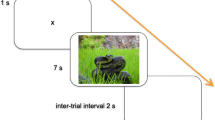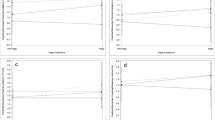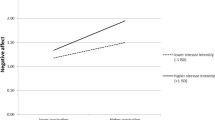Abstract
Background: Suppression of emotion, anger in particular, may be linked to heightened pain intensity during a subsequent painful event, but it is not clear whether an individual’s anger management style (trait anger-out or trait anger-in) moderates effects on pain intensity and cardiovascular responses during pain.Purpose: To determine whether (a) trait anger-out and/or trait anger-in moderate effects of Emotion-Induction (anger, anxiety)×Emotion Suppression (nonsuppression, experiential, expressive) manipulations during mental arithmetic on pain intensity and cardiovascular responses during and following a cold pressor pain task, such that “mismatch” relationships emerge (preferred anger management style is discrepant from situation demands), and (b) general emotional expressivity accounts for these effects.Method: Healthy nonpatients (N=187) were assigned to 1 of 6 conditions for a mental arithmetic task. Cells were formed by crossing 2 Emotion-Induction (anxiety, anger)×3 Emotion Suppression (non-suppression, experiential, expressive) conditions. After mental arithmetic, participants underwent a cold pressor followed by recovery. Systolic blood pressure (SBP), diastolic BP (DBP), heart rate (HR), and pain intensity ratings were recorded. Spielberger Anger Expression Inventory tapped anger management style.Results: General Linear Model procedures tested Emotion-Induction×Emotion Suppression×Anger-Out or Anger-In (continuous)×Period (baseline, cold pressor, recovery) effects on pain intensity, SBP, DBP, and HR. A 4-way interaction emerged for pain intensity: Only for those in the anger-induction/experiential suppression condition, anger-out was related significantly to pain recovery. Three-way interactions emerged for SBP and DBP: Only for those in expressive suppression condition, anger-out was related significantly to SBP during and following cold pressor and to DBP following cold pressor. General emotion expressivity did not account for anger-out effects.Conclusions: A mismatch situation may apply for high anger-out people who suppress emotion in a certain circumstance and thus may suffer greater discomfort and physiological responsiveness to subsequent pain than high anger-out people not having to suppress.
Similar content being viewed by others
References
Banks SM, Kerns RD: Explaining high rates of depression in chronic pain: A diathesis-stress framework.Psychological Bulletin. 1996,119:95–110.
Keefe FJ, Rumble ME, Scipio CD: Psychological aspects of persistent pain: Current state of the science.Journal of Pain. 2004,5:195–211.
Berkowitz L: On the formation and regulation of anger and aggression: A cognitive-neoassociationistic analysis.American Psychologist. 1990,45:494–503.
Berkowitz L: Pain and aggression: Some findings and implication.Motivation and Emotion. 1993,17:277–293.
Berkowitz L, Harmon-Jones E: Toward and understanding of the determinants of anger.Emotion. 2004,4:107–130.
Burns JW: Arousal of negative emotions and symptom-specific reactivity in chronic low back pain patients.Emotion. 2006,6:309–319.
Janssen SJ, Spinhoven P, Brosschot JF: Experimentally induced anger, cardiovascular reactivity, and pain sensitivity.Journal of Psychosomatic Research. 2001,51:479–485.
Bruehl S, Burns J, Chung OY, Ward P, Johnson P: Anger and pain sensitivity in chronic low back pain patients and pain-free controls: The role of endogenous opioids.Pain. 2002,99:223–233.
Burns JW, Johnson BJ, Mahoney N, Devine J, Pawl R: Anger management style, hostility and spouse responses: Gender differences in predictors of adjustment among chronic pain patients.Pain. 1996,64:445–453.
Kerns RD, Rosenberg R, Jacob MC: Anger expression and chronic pain.Journal of Behavioral Medicine. 1994,17:57–67.
Engel G: “Psychogenic” pain and the pain prone patient.American Journal of Medicine. 1959,26:899–918.
Wegner DM: Ironic processes of mental control.Psychological Review. 1994,101:34–52.
Quartana PJ, Burns JW: The painful consequences of anger suppression.Emotion 2007,7:400–414.
Wegner DM, Erber R: The hyperaccessibility of suppressed thoughts.Journal of Personality and Social Psychology. 1992,63:903–912.
Wegner DM, Erber R, Zanakos S: Ironic processes in mental control of mood and mood related thought.Journal of Personality and Social Psychology. 1993,65:1093–1104.
Wegner DM, Shortt JW, Blake AW, Page MS: The suppression of exciting thoughts.Journal of Personality and Social Psychology. 1990,58:409–418.
Wegner DM, Gold DB: Fanning old flames: Emotional and cognitive effects of suppressing thoughts of a past relationship.Journal of Personality and Social Psychology. 1995,68:782–792.
Wenzlaff RM, Rude SS, Taylor CJ, Stultz CH, Sweatt RA: Beneath the veil of thought suppression: Attentional bias and depression risk.Cognition and Emotion. 2001,15:435–452.
Newman LS, Duff KJ, Baumeister RF: A new look at defensive projection: Thought suppression, accessibility, and biased person perception.Journal of Personality and Social Psychology. 1997,72:980–1001.
Petrie KJ, Booth RJ, Pennebaker JW: The immunological effects of thought suppression.Journal of Personality and Social Psychology. 1998,75:1264–1272.
Tolin DF, Abramowitz JS, Przeworski A, Foa EB: Thought suppression in obsessive-compulsive disorder.Behaviour Research and Therapy. 2002,40:1255–1274.
Cioffi D, Holloway J: Delayed costs of suppressed pain.Journal of Personality and Social Psychology. 1993,64:274–282.
Spielberger CD, Johnson EH, Russell SF, et al.: The experience and expression of anger: Construction and validation of an anger expression scale. In Chesney MA, Rosenman RH (eds),Anger and Hostility in Cardiovascular and Behavioral Disorders. Washington, DC: Hemisphere, 1985, 5–30.
Engebretson TO, Matthews KA, Scheider MF: Relations between anger expression and cardiovascular reactivity: Reconciling inconsistent findings through a matching hypothesis.Journal of Personality and Social Psychology. 1989,57:513–521.
Lai JY, Linden W: Gender, anger expression style, and opportunity for anger release determine cardiovascular reaction to and recovery from anger provocation.Psychosomatic Medicine. 1992,54:297–310.
Faber SD, Burns JW: Anger management style, degree of expressed anger, and gender influence cardiovascular recovery from interpersonal harassment.Journal of Behavioral Medicine. 1996,19:31–53.
Burns JW, Bruehl S, Quartana PJ: Anger management style and hostility among chronic pain patients: Effects on symptom-specific physiological reactivity during anger- and sadness-recall interviews.Psychosomatic Medicine. 2006.68:786–793.
Burns JW, Bruehl S, Caceres C: Anger management style, blood pressure reactivity and acute pain sensitivity: Evidence for a “trait×situation” model.Annals of Behavioral Medicine. 2004,27:195–204.
Burns JW, Kubilus A, Bruehl S: Emotion-induction moderates effects of anger management style on acute pain sensitivity.Pain. 2003,106:109–118.
Spielberger CD, Jacobs G, Russell S, Crane R: Assessment of anger: The State-Trait Anger Scale. In Butcher JN, Spielberger CD (eds),Advances in Personality Assessment (Volume 2). Hillsdale, NJ: Lawrence Erlbaum Associates, 1983, 161–189.
Kring AM, Smith DA, Neale JM: Individual differences in dispositional expressiveness: Development and validation of the Emotional Expressivity Scale.Journal of Personality and Social Psychology. 1994,66:934–949.
Burns JW, Katkin ES: Psychological, situational, and gender predictors of cardiovascular reactivity to stress: A multivariate approach.Journal of Behavioral Medicine. 1993,16:445–465.
Caceres C, Burns JW: Cardiovascular reactivity to psychological stress may enhance subsequent pain sensitivity.Pain. 1997,69:237–244.
Dahlen ER, Deffenbacher JL: Anger management. In Lyddon WJ, Jones JV Jr (eds),Empirically Supported Cognitive Therapies: Current and Future Applications. New York: Springer, 2001, 163–181.
Burns JW, Quartana PJ, Bruehl S:Anger Inhibition and Pain: Toward a New Conceptualization (under review).
Tabachnik BG, Fidell LS:Using Multivariate Statistics (5th Ed). Boston: Pearson Eduction, 2007.
Brosschot JF, Thayer JF: Anger inhibition, cardiovascular recovery, and vagal function: A model of the link between hostility and cardiovascular disease.Annals of Behavioral Medicine. 1998,20:326–332.
Author information
Authors and Affiliations
Additional information
This research was supported in part by Grants NS37164 from the National Institute of Neurological Disorders and Stroke (John W. Burns, Ph.D.), MH071260 from the National Institute of Mental Health (John W. Burns, Ph.D. and Stephen Bruehl, Ph.D.), NS046694 from the National Institute of Neurological Disorders and Stroke (Stephen Bruehl, Ph.D.), and by Grant F31 NS051200-01A1 from the National Institute of Neurological Disorders and Stroke (Phillip J. Quartana, M.S.).
About this article
Cite this article
Burns, J.W., Quartana, P.J. & Bruehl, S. Anger management style moderates effects of emotion suppression during initial stress on pain and cardiovascular responses during subsequent pain-induction. ann. behav. med. 34, 154–165 (2007). https://doi.org/10.1007/BF02872670
Issue Date:
DOI: https://doi.org/10.1007/BF02872670




